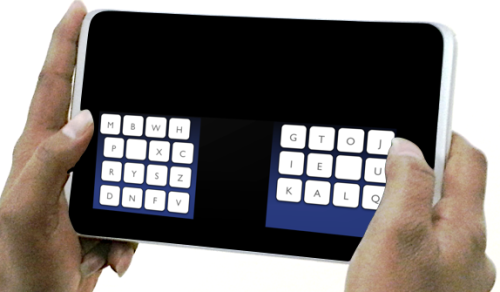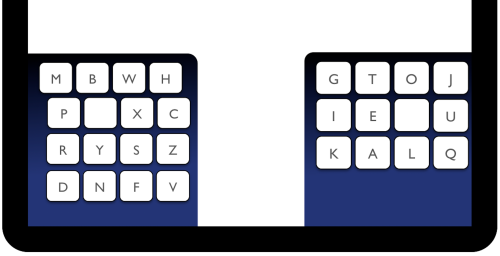A new keyboard called KALQ, created by researchers from the Max Planck Institute for Informatics, University of Montana, and the University of St. Andrews, enables users to thumb-type on touchscreen devices 34% faster than if they were to use a QWERTY keyboard instead.

Researchers have developed a new keyboard called the KALQ to improve the thumb typing speed on touchscreen devices.
The new board was developed using computational optimization techniques coupled with a model of common thumb movements. By combining this data, the researchers explored millions of potential layouts, before identifying one — the KALQ — as yielding the best performance.
Why make the switch from QWERTY?
As smart devices continue to proliferate today’s society, thumb-typing is fast becoming a form of typing worth legitimizing. To that end, the QWERTY keyboard is ill-suited for this new method of communication, which is no real surprise as it was developed specifically for typing with both hands.
Studies have been done in the past to see just how much the QWERTY keyboard slows down the thumb typist. Approximately speaking, a person typing with their thumbs using a QWERTY keyboard achieves a rate of 20 words per minute.
To say that’s a bit slow would be a severe understatement.
The researchers recognized the inefficiency of the current set-up and set out to create an alternative, better performing model.
Important considerations
The group started out by exploring whether or not they could make some superficial adjustments to the present day QWERTY keyboard – move a key here, replace a key there.
This didn’t last long though — words like “on,” “see,” “you,” read,” “based,” and more, all fairly frequently typed words, all containing a range of letters to them, all require being typed with one thumb, a most burdensome process as anyone who’s ever typed out the phrase “Oh say can you see” will tell you.
So the researchers decided they needed to dive a little deeper and really explore the data behind typing behavior to find a find a layout that works best.
Two goals were established for this study: (1) Minimize the moving time of the thumbs and (2) Approximate alternating sides as well as possible.
Dr. Antti Oulasvirta, who led the research team: “The key to optimizing a keyboard for two thumbs is to minimize long sequences with a single thumb. We also want to place frequently used letters centrally close to each other. Experienced typists move their thumbs simultaneously: While one is typing, the other is approaching its next target. We derived a predictive model of this behaviour for the optimization method.”
Results of the study
A solution like the KALQ keyboard was entirely unexpected. You see, board’s layout features all vowels, except for “y”, in an area for the right thumb; the left thumb, meanwhile, has more consonants and also more keys to choose from on its side.

How the KALQ keyboard is laid out.
To maximize the keyboard’s performance, users were trained to use both thumbs at the same time; that is, while the left thumb is striking the various consonants within a word, the right thumb is searching for the appropriate vowels.
Dr. Per Ola Kristensson, who also contributed to the study, reflected on the improvements a KALQ keyboard offers over a QWERTY model: “The legacy of QWERTY has trapped users with suboptimal text entry interfaces on mobile devices. However, before abandoning QWERTY, users rightfully demand a compelling alternative. We believe KALQ provides a large enough performance improvement to give users the incentive to switch and benefit from faster and more comfortable typing.”
To ensure errors are kept to a minimum, the group developed probabilistic error correction methods based on statics of how users move their thumbs, and also statistical knowledge about the texts a typical user types most often. This error correction method allowed trained users to type even quicker than before while retaining an acceptable level of errors.
Statistically speaking, the new KALQ keyboard helped users achieved an average rate of 37 words per minute, the best ever reported for two-thumb-typing on a touchscreen device.
Moving forward
Drs. Oulasvirta and Kristensson, along with the other researchers, will present their work on the KALQ keyboard at the CHI 2013 conference in Paris on May 1st. You can download their paper via the link below.
The KALQ keyboard will be made available for free download for Android-based smartphones come early May.
For more information, visit mpi-inf.mpg.de
Story via: mpg.de
Advertisement
Learn more about Electronic Products Magazine





